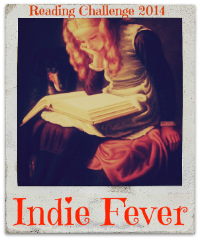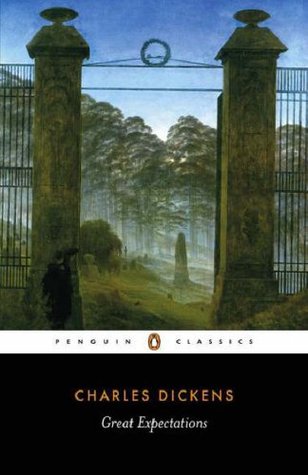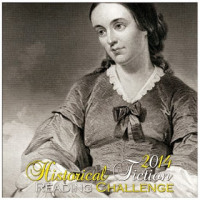Katherine Nabity's Blog, page 206
July 14, 2014
Wicked Wildfire Read-a-Thon 2014 (#WWReadathon)

Hosted by My Shelf Confessions
The Wicked Wildfire Read-A-Thon is a time when we all get together to dedicate the days of July 14-24 to as much reading as possible. You read as much as you can in order to get yourself a little further through that huge to-read pile! We know real life gets in the way and even if you can’t participate more than one day, you’re welcome to join in on the fun!
Goals, Reading List, You Know the Drill
Low pressure, I-need-to-get-work-done, but I still want to read with you all too! Here’s some of what I’ll be reading:
Great Expectations by Charles Dickens
Vaclav & Lena by Haley Tanner
“Every Mystery Unexplained” by Lisa Mason, a hefty “short” story for Deal Me In
For #COYER – Spirit Slate Writing and Kindred Phenomena by William E. Robinson
Also for #COYER, a few other short stories.
I’m really bad at sticking to lists. Even short ones.
Progress
Challenges & Notes
Monday: Took Daily Mayo’s super fun Book Cover Quiz. Managed 12/12 with some darn lucky guesses!


July 13, 2014
#COYER Fairy Tales with a Twist Reviews
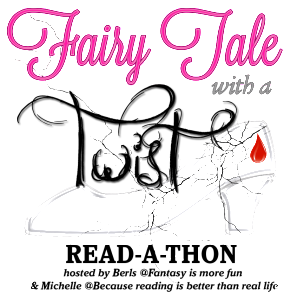
July 11th – 13th: Fairy Tales with a Twist
Read fairy tale re-tellings and give those childhood favorites a twist!
Supernatural Fairy Tales by Dorlana Vann
With nods to some classic fairy tales, this collection certainly fit the bill. “Blueberry Eyes” is the easiest to identify as a twisted tale, but as Vann notes in her afterword, all are inspired by classic fairy tales. How do the Emperor’s New Clothes look on a vampire? What happens when an artist finds “His Soul Inspiration” in the old tales and paints his wife as a mermaid? There are a few neat concepts in Supernatural Fairy Tales. My only criticism is that the stories often play with the concept of memory and the narratives end up being a little muddled. My favorite: “The Gift” because I can’t resist the Weird West.
The Storyteller’s Wife by Eugie Foster
“If this was…a real fairy tale, she knew her lines.”
Not a twisted tale, but a tale of faerie and one so very bittersweet. Eugie Foster might be my favorite fairy tale writer. Yes, beating out even Peter S. Beagle.
Never Ever After: Three Short Stories by Ruth Nestvold
It’s hard to get into an already existing fantasy world, which is what it felt like I was doing in “A Serca Tale.” Even the title leaves me a bit short in the info department. I did not finish “King Orfeigh” because I can’t get my head into a second person POV. “Happily Ever Awhile” was the best of the trio with the best title of the entire readathon.


Deal Me In, Week 28 ~ “Lazarus”
Hosted by Jay @ Bibliophilopolis
“Lazarus” by Leonid Andreyev
Card picked: Five of Hearts – a WILD card
From: http://www.eastoftheweb.com/short-stories/UBooks/Laza841.shtml
Review: A story that Jay read back in March that sounded intriguing.
When reading classic literature, I always end up having a little war with myself. How “genre” do I want to let my reading be? How much do I want to force a “literary” interpretation? The dichotomy leaves me grumpy because I don’t believe that one of these things is more important than the other, but one might actually be more appropriate.
I have a tin ear when it comes to appropriateness.
Andreyev begins with a description that would cast Lazarus in any zombie movie ever. And if we want to look at Lazarus with modern trope-infused eyes, that’s exactly what he is. He was dead for three days, decomposed for three days, and now he’s alive again. He is an unnatural thing, a breaking of natural laws. Anyone who looks upon Lazarus and has Lazarus look on them knows this and feels the implication. According to Wikipedia, Lovecraft had Andreyev in his library and I’m not surprised. This sort of concept is very much what a genre reader would call Lovecraftian.
The other genre standard that came to mind was Frankenstein. For me, the main theme of Frankenstein is the taking, or rather the shirking, of responsibility by a creator. Andreyev never mentions how the miracle of Lazarus’s resurrection occurs, just that is has happened. The responsible party is not at all in evidence. Is this Andreyev taking the story out of context to suit his storytelling whim? Or is he making comment by never mentioning what most readers of this story know? In any case, Lazarus’s family and community forsake him as well. No one is willing to take responsibility for the monster at the edge of town.
(I reread the biblical account of Lazarus. It does seem to be the event that kicks off the earnest plotting against Jesus. Jesus pretty much goes into hiding for a while afterward to avoid immediate persecution.)
The literary side of my brain wonders what Andreyev was going on about with this character and his travels. I could probably make a point about the encroachment of Christianity on the Classical world and, if I knew my Russian history better, how that might parallel some aspect of the Russian revolution. I can also see in it a parallel with original sin. Lazarus possesses knowledge of something which shouldn’t be known. Like Eve eating from the Tree of Knowledge, he spreads this to others, and not to their benefit.
Were Death itself passing, it would be faced with no greater fear: for until then the dead alone knew Death, and those alive knew Life only—and there was no bridge between them. But this extraordinary man, although alive, knew Death, and enigmatical, appalling, was his cursed knowledge.
Which does lead back to Lovecraftian notions of forbidden knowledge.
I am curious about the whole “dressed as a bride-less bridegroom” thing. I feel like I’m missing something cultural.
About the Author:
Via Wikipedia
Leonid Nikolaievich Andreyev (21 August [O.S. 9 August] 1871 – September 12, 1919) was a Russian playwright, novelist and short-story writer. He is one of the most talented and prolific representatives of the Silver Age period in Russian history. Andreyev’s style combines elements of realist, naturalist and symbolist schools in literature.


July 10, 2014
#COYER Read-athon – Fairy Tales with a Twist

July 11th – 13th: Fairy Tales with a Twist
Read fairy tale re-tellings and give those childhood favorites a twist!
The Rules
Sign up!
Sometime between now and the end of the read-a-thon post on your blog, twitter, FB, Google+, Goodreads, Booklikes (you get the idea… somewhere!) that you’re participating. That’s the link you’ll need for the Rafflecopter.
Read books that are in someway related to a fairy tale. When you finish a book do a general update with a link that you can put on the Rafflecopter. Example – on Goodreads you could write: “Great, cute book! 4 stars! Full review coming soon!” and that would count. (For COYER participants, just do something quick and then update with full review for COYER linky)
Have FUN!!!
Not sure if all of these will count as retellings, but they’re definitely in the fairy tale vein.
Supernatural Fairy Tales by Dorlana Vann
The Story Teller’s Wife by Eugie Foster
Never Ever After: Three Short Stories by Ruth Nestvold


July 8, 2014
Short Review ~ Penn & Teller’s How to Play in Traffic
While Star Trek fans, role-playing game fans, and even comic book fans eventually find each other and develop something like social groups, teenage magicians are, due to the rarity of their particular geek kink, more likely to remain socially retarded than any other group. That isolation and talent for magic allowed Penn & Teller a great deal of time to devote to revenge, mayhem, and making others look foolish. Now they share their techniques, as well as the wisdom one gains from acquiring happiness only after being ostracized and ridiculed, in Penn & Teller’s How to Play in Traffic. A mixture of tricks you can do in hotel rooms, cars, and planes, some ill-advised methods for screwing with the minds of airport security personnel, and a series of memoirs of the unusual people they’ve met on their B-venue journeys around the world, How to Play in Traffic is not only funny (as one would expect from Penn & Teller) but also oddly insightful. (via Goodreads)
Take note of the publication date. Despite what you might think of the TSA, some of the airport tricks are *very* ill-advised. Just sayin’. And as with How to Play with Your Food, there is a certain level of trick exposé in this book. If you are utterly against knowing how illusions are done, this isn’t the book for you.
After all those disclaimers, I’ll say that this is slightly less magic-tricky than How to Play with Your Food. The travel stories are the best aspect of this book. Honestly, I’d love a more straight-on travel book from Penn & Teller, before and after fame. It was also a little easier to tell which sections were written by which author, though I do wonder how the collaborative effort works between these two as writers.
Publisher: Berkley Trade
Publication date: November 1st 1997
Genre: non-fiction


July 7, 2014
Magic Monday Review ~ Miracle Mongers and Their Methods
I like Mondays. On Monday, I am refreshed from the weekend and exhilarated by the possibilities of the week ahead. I also like magic. I like its history, its intersection with technology, and its crafty use of human nature. I figured I’d combine the two and make a Monday feature that is truly me: a little bit of magic and a look at the week ahead.
Miracle Mongers and Their Methods by Harry Houdini
The legendary magician and illusionist Harry Houdini turns a critical eye to the astonishing claims of those in his own profession. Using personal research and observations, Houdini reveals the cunning techniques employed by fire-eaters, sword swallowers, and other masters of deception to mystify and amaze audiences around the world. This classic skeptical work explores and exposes the methods of such “wonders” as “The Incombustible Spaniard,” “Defiers of Poisonous Reptiles,” and many others. Originally published in the 1920s, Miracle Mongers and Their Methods scrupulously examines the direct predecessors of modern psychics and mentalists. …(via Goodreads)
Making the jump to debunking psychics and mediums misses a rather important point about Houdini. He was an incredible athlete. Near the end of his career, he did indeed pit himself against mediums, but this book isn’t about that at all. This book is a catalog of the great purveyors of physical “miracles.” While Houdini does expose the techniques, there’s a great respect in this recitation of fire-eaters, sword-swallowers, poison defiers, strong men (and women) and the like. While Houdini was sensitive about his own methods being made public, he makes an important observation about exposure: Many of these performers were debunked time and time again during their careers without it hurting business.
I would guess that the text wasn’t really written by Houdini (he had ghost writers), but the source material was curated by him and I would say that the enthusiasm is certainly his. It should also be noted that any advice given about snake bite cures in this book is *terrible*.
Publisher: Public domain edition
Publication date: Originally 1920
Genre: non-fiction

What Am I Reading This Week?



Nevermore by William Hjortsberg – Arthur Conan Doyle, Harry Houdini, and the ghost of Edgar Allan Poe walk into a bar…
Great Expectations by Charles Dickens – I always forget how much I enjoy Dickens.
A wild card for DMI and I’m picking “Lazarus” by Leonid Andreyev
A book of optical illusions
Some fairy tales retold for #COYER on the weekend!
What Am I Working On?
The first week of writing in July didn’t go as well as planned. I wasn’t feeling great and I got hung up on an action scene. I hate action scenes.
Also this week, I need to update ALL THE WEBPAGES. Entangled Continua got a mini make-over this weekend and I need to update book availability.


July 5, 2014
Deal Me In, Week 27 ~ “The Eighth Voyage of Sinbad”
Hosted by Jay @ Bibliophilopolis
But first, a mid-year survey from Jay
Do you have a favorite story or author so far? The two easy picks would be “Eisenheim the Illusionist” (which feels like cheating since it was a re-read) and “The Barnum Museum,” both by Steven Millhauser. The real surprise, going back through my posts, was “Fat Man and Little Boy” by Gary Braunbeck.
What is your major “discovery” from DMI this year? Either from the posts of fellow participants or from your own story roster – or both. Every week, I am overwhelmed by how much good literature has already been written. I think there is at least one story per wrap-up post that is a “classic” that I haven’t read, but, boy, do I want to. Book bloggers sometimes get wrapped up in the NEW! when there is so much already there.
Would you participate in the challenge again in 2015? Yes!
Do you think a weekly wrap-up post is necessary? Would you prefer a monthly wrap-up? I like the weekly post because it keeps things in a nice sized chunk for checking out. (I totally spaced last week, I’d hate to think of spacing a post with a whole month’s worth of links!)
Do you have any good ideas for suit “themes” to share for others who might try the challenge again? I like the idea of themes, but really, I’m way too lazy to plan them. This year, I took three anthologies that I wanted to read, assigned each to a separate suit, used the fourth suit for “clean up,” and filled in with other stories I wanted to read. I’ll probably do the same next year.
Have you gotten much of a response from other readers of your blog (other than fellow DMI’ers I mean)? Not a lot of response, but I’m a small fry in the land of blogging.
Can you recommend any good resources (on line or otherwise) for those looking to populate their DMI roster? PaperbackSwap; if you’re looking for science fiction/fantasy, SF Signal has a regular listing of free genre fiction, as well as ToC posts from some of the free-content genre magazines; Project Gutenberg.
Does DMI rate favorably in comparison with other book blogging challenges in which you’ve participated? Why or why not? Not that I wish for DMI not to spread, but I like the smallness of the group. I realized a couple weeks back that I had signed up for another challenge that’s so big that no one really comments or visits.
What is/are your favorite part/parts about The Deal Me In challenge? To sum-up the above: Lots of great literature being read by a group of friendly, intelligent people.
Conversely, what do you NOT like about the challenge or what would you change about it? Hmm. I like to give some constructive criticism, but nothing is coming to mind.
Feel free to add any other general comments. I’ve made a short story a week a goal in the past, and two things happen. I quit about halfway through the year and I never end up writing about the stories. DMI is a good way for me to do both!
“The Eighth Voyage of Sinbad” by Steven Millhauser
Card picked: Five of Diamonds
From: The Barnum Museum
Review: I have the same relationship with Steven Milhauser’s stories that I have with Coen Brothers movies: Some are my favorites of the medium, some I do not get; there is no middle ground. The advantage with movies is, I can watch a trailer and easily decide whether I’m going to get a pleasing experience. Right now, picking a low diamond is a little like the spin of the wheel (to mix my gambling metaphors). What will I get?
“The Eighth Voyage of Sinbad” is one of the longer pieces in The Barnum Museum and one of the most structured. Each section of the story has three paragraphs, Millhauser isn’t shy about big, chunky paragraphs. The first paragraph is about Sinbad, now an old man who can’t quite decide if his voyages are memories, tales he once told, or maybe a combination of both. The second paragraph is about the history of the Sinbad the Sailor stories, their variations, translations, and the story-with-in-a-story-structure of the Arabian Nights. The third paragraph is Sinbad’s first-person POV telling of his eighth voyage, which is an amalgamation of aspects mentioned in the previous sections. The popular reader in me rolls my eyes at this sort of very literary “storytelling.” It could go wrong in so many ways, but in this case, Millhauser makes it work.
…Sinbad can summon to mind, with sharp precision, entire adventures or parts of adventures, as well as isolated images that suddenly spring into enchanted life behind his eyelids, there in the warm shade of the orange tree, and so it comes about that within the seven voyages new voyages arise, which gradually replace the earlier voyages as the face of an old man replaces the face of a child.
It doesn’t hurt that both of the best part of Millhauser is in this story. The old man’s paragraphs have all the colorful imagery I’ve come to appreciate, and the “academic” paragraphs all the arcane details. The third paragraph marries the two together in an actual narrative. It’s a really nice piece on the mutability of stories and memories.


July 2, 2014
What Else in June
What did I even do in June? That’s not a good question to ask, but there it is.
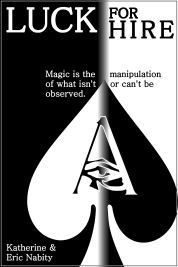 Luck for Hire ended its stint on KDP Select on July 1st. In the end, the program didn’t work well for us. We’re trying to build audience right now, and that’s hard when you’re only allowed to price change your book for 5 days out of 90, and within a limited manner. Luck is now on Smashwords for free and will soon be available at Barnes & Noble.
Luck for Hire ended its stint on KDP Select on July 1st. In the end, the program didn’t work well for us. We’re trying to build audience right now, and that’s hard when you’re only allowed to price change your book for 5 days out of 90, and within a limited manner. Luck is now on Smashwords for free and will soon be available at Barnes & Noble.
I didn’t make much progress on In Need of Luck in June, but I now have a word goal plan which makes me happy. Eric set for me (because it doesn’t work if I set the goal myself) a goal of 1500 words daily, 5000 words weekly. “Katherine,” I hear you saying, “that doesn’t make a whole lot of sense.” I have the tendency to only write to my goal and not further. The weekly goal allows for bad days, planning, research, and what-not. The daily goal is meant to keep me stretched.
Formatted PHYSIC for CreateSpace, which was a little more challenging due to the epigraphs. Formatting a print book is an interesting process. You want a noticeable consistency in how things look. I had placed the chapters right after the epigraphs, and then had chapters starting at various places on the page. It made sense having the two things connected, but it looked like a mess. Starting chapters on the following page looked *much* better. PHYSIC is still available for free in various electronic formats, but now it’s available in paperback too!
Other Life Stuff
We spent a week in San Diego. Eric plays with Crawl, the Phoenix master’s ultimate frisbee team, and the regional tournament was in California. We drove out on Tuesday, the 17th, in order to spend time with our friend Chris who currently has Weds/Thurs off. We hit the beach, played some pickup ultimate, and Eric and I spent Friday at Balboa Park. After taking in the ILLUSION exhibit, we wandered into whatever had free admission. I took exactly four pictures. Here are two of them, the Botanical Building and Lily Pond:
I could see myself spending an inordinate amount of time at Balboa Park if we lived in San Diego. And I’d spend a fortune on museum memberships.
 Saturday and Sunday were the frisbee tournament. After going 3-0 on Saturday, Crawl lost the first place game on Sunday morning (replaying the last team they played on Saturday). They then beat the winner of the 3/4 game and secured 2nd place. Good enough for a bid to Nationals in Florida. Unfortunately, Eric and I won’t be going to Florida. It’s just too expensive for two writers who are building audience. *cough*
Saturday and Sunday were the frisbee tournament. After going 3-0 on Saturday, Crawl lost the first place game on Sunday morning (replaying the last team they played on Saturday). They then beat the winner of the 3/4 game and secured 2nd place. Good enough for a bid to Nationals in Florida. Unfortunately, Eric and I won’t be going to Florida. It’s just too expensive for two writers who are building audience. *cough*
And since Eric and I celebrated our 14th wedding anniversary on Monday, I feel obligated to post a picture of him playing, which he’ll hate. The photo is not mine, but by one of our resident VOTS photographers, Quan Nguyen.


July 1, 2014
Review ~ The Swan Gondola
On the eve of the 1898 Omaha World’s Fair, Ferret Skerritt, ventriloquist by trade, con man by birth, isn’t quite sure how it will change him or his city. Omaha still has the marks of a filthy Wild West town, even as it attempts to achieve the grandeur and respectability of nearby Chicago. But when he crosses paths with the beautiful and enigmatic Cecily, his whole purpose shifts and the fair becomes the backdrop to their love affair.
One of a traveling troupe of actors that has descended on the city, Cecily works in the Midway’s Chamber of Horrors, where she loses her head hourly on a guillotine playing Marie Antoinette. And after closing, she rushes off, clinging protectively to a mysterious carpetbag, never giving Ferret a second glance. But a moonlit ride on the swan gondola, a boat on the lagoon of the New White City, changes everything, and the fair’s magic begins to take its effect. (via Goodreads)
I’ve always taken note of the fact that the Wizard of Oz was from Omaha. I suppose that considering that the Wizard is a con man maybe this is an indictment of my city, but when you grow up somewhere like Omaha, you take what you can get. Timothy Schaffert took note too and wrapped the Wizard in the clothes of the 1898 Trans-Mississippi Exposition, or the Omaha’s World Fair. The Swan Gondola isn’t any sort of The Wizard of Oz retelling, but it definitely nods and winks in its direction.
Omaha of this period, and especially the 30 years after, is of interest to me. If I would have been a smarter kid, I would have paid a whole lot more attention on field trips to the history museums. Schaffert has definitely done his research and his Omaha of 1898-99 can best be described in Ferret Skerritt’s own words as “exuding shabby romance.” Indeed, the setting is the best part of The Swan Gondola. Not only is it the Omaha of the Trans-Mississippi Exposition, but it’s Ferret’s Omaha. Sort of Victorian seedy. Along with setting, the secondary characters really shine. Two-spirited August Sweetbriar and Pearl the counter girl at Brandeis are almost more solid than Ferret, our narrator, and the nearly ghostly Cecily.
The plot was the weak part for me. I’m going to admit that I’m not a romantic person. Swooning love stories leave me impatient. For me, most of Ferret’s decisions play as selfish, despite his devotion to Cecily and Doxie. Ferret would be the sort of chess player that never thinks more than a move ahead; always reacting to his opponent, occasionally getting bailed out by friends, and mostly just being lucky.
I had crazy high expectations for this book. While it fell a little short, it was still very enjoyable with a magical atmosphere that I don’t find often in historical fiction.
Publisher: Riverhead Hardcover
Publication date: February 6th 2014
Genre: Historical fiction


June 30, 2014
Magic Monday Reviews ~ Houdini: A Life Worth Reading & Vera Van Slyke stories
I like Mondays. On Monday, I am refreshed from the weekend and exhilarated by the possibilities of the week ahead. I also like magic. I like its history, its intersection with technology, and its crafty use of human nature. I figured I’d combine the two and make a Monday feature that is truly me: a little bit of magic and a look at the week ahead.
Houdini: A Life Worth Reading by Higher Read
Houdini was a man of magic and mystery. He was also a pilot, an author, an actor, and a rabid opponent of the Spiritualist movement. He was impatient of charlatans and imitators and loving to his family. He had an impressive ego. If any of these facts are new to you, then Houdini: A Life Worth Reading is the perfect primer on the man who was, by the end of his life, known only as Houdini. (via Goodreads)
I picked this up as a freebie from Amazon back in March. I don’t know what’s up with Higher Read as an “author,” but this short biography was well written and included chapter overviews and study questions. If, you know, you find Houdini to be an important enough guy to study. (Higher Read also has books on Woodrow Wilson, John F. Kennedy, and Thomas Jefferson.) In fact, I was pretty impressed with how neutral the biography is. It makes no bones about Houdini’s greatness as a showman and publicist or his massive ego. If I learned anything from this Houdini bio, it was that Houdini was sued more often than I had thought!
Publisher: Higher Read, LLC
Publication date: January 30th 2014
Genre: Biography
“The Minister’s Unveiling” & “The Ghost of Banquo’s Ghost” by Tim Prasil
 Tim Prasil’s Help for the Haunted stories are based on the manuscripts left to him by his great-grandaunt. The stories involve his great-grandaunt, Lucille, and her friendship with Vera Van Slyke, a journalist and occult detective in the early 1900s. Vera investigates hauntings and tries to put ghosts to rest. She’s smart, if occasionally absent-minded about frivolous details like personal names, and makes no apologies for it. Lucille, a debunked spirit medium, likes adventure a little more than a proper lady should and is game to help Vera in her investigations. There a great Holmesian/Watsonian(?) duo. The stories are fun with an appealing mixture of skepticism and the supernatural. Also it’s nice to see two women *doing things* in fiction. Both of these stories are currently free on Tim Prasil’s website, but only for a little while longer as he offers new stories. The third story “Skittering Holes” was released over the weekend!
Tim Prasil’s Help for the Haunted stories are based on the manuscripts left to him by his great-grandaunt. The stories involve his great-grandaunt, Lucille, and her friendship with Vera Van Slyke, a journalist and occult detective in the early 1900s. Vera investigates hauntings and tries to put ghosts to rest. She’s smart, if occasionally absent-minded about frivolous details like personal names, and makes no apologies for it. Lucille, a debunked spirit medium, likes adventure a little more than a proper lady should and is game to help Vera in her investigations. There a great Holmesian/Watsonian(?) duo. The stories are fun with an appealing mixture of skepticism and the supernatural. Also it’s nice to see two women *doing things* in fiction. Both of these stories are currently free on Tim Prasil’s website, but only for a little while longer as he offers new stories. The third story “Skittering Holes” was released over the weekend!
Publisher: To be published later in the year in novel form from Emby Press
Genre: Ghost mysteries.

